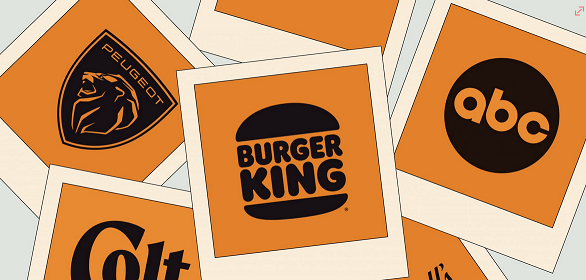This year, heritage brands looked to their pasts to create visual identities for the multi-platform era
In a year packed with change, a certain shade of nostalgia has taken hold of branding design. A number of legacy brands, from Burger King to Campbell’s Soup to Colt 45, ABC, Zagat, and Peugeot, drew on their archives to create new looks. The unfussy lettering, crisp lines, and pared-down color palettes of these rebrands look like stylish cartoon versions of the original logos. They have the visual efficiency, if not exactly the style, of Hanna-Barbera’s golden age.
“There is something that changed this year that made this aesthetic and this approach not just acceptable, but really successful in the marketplace,” says Armin Vit, co-founder of UnderConsideration. Vit says Jones Knowles Ritchie’s Burger King rebrand, which made headlines in January, made consumers want to engage with the brand in a way that they hadn’t felt the need to before. While Vit agrees there have been more archive-referencing rebrands since then, he says it’s hard to know how many of them were already in progress before Burger King’s fresh-but-familiar look became a hit. It should be noted that despite media coverage to the contrary, JKR’s executive creative director, Lisa Smith, doesn’t characterize the rebrand as an homage to the restaurant’s glory days. While the new logo is a take on the longstanding previous Burger King sign, other elements—from the Kraft paper packaging to the elegant favicon—are entirely original.

Burger King rebrand by Jones Knowles Ritchie.
This trend is one part practical, one part cultural. Midcentury graphic design, which straddled the print and emerging digital worlds of its time, had technical restrictions that resulted in simpler, more abstract work. Accents like drop shadows and gradients had to be done by hand. There were far fewer typefaces to choose from. So by default, most logos created between the mid 1950s and 1970s were what we now call flat design: two-dimensional, characterized by blocks of color and a general lack of filigree. While the textured visual identities of the 1990s and 2000s—think the glint on Windows 2000—don’t translate well to small-scale digital screens, the unadorned designs of the midcentury era lend themselves well to today’s multi-platform landscape.
Modern brands live in lots of places. Social media accounts, digital ads, and apps add a new dimension to the world of storefronts, websites, and print. That increased exposure, along with the forum for superficial nitpicking that the internet provides, has made consumers—and brands themselves—care more about branding than ever before. Vit pinpoints mainstream interest in corporate identity back to 2010. That year, the Gap unveiled a new logo: a black Helvetica wordmark, layered over a gradient blue box on the upper-right-hand corner. Since 1986, the retailer’s logo had been a narrow, white wordmark in a navy blue square. It was a big, unpopular change. The backlash, which played out via customer comments on Twitter and Facebook, garnered media attention. The sites that covered the debacle read like a who’s who of digital media circa 2010: Slate and Refinery29 blogged about it. Gap chairman Bob Fisher posted a response on Huffington Post. A week later, the company reverted to its former logo. While brands have long known that consumers are wont to grow attached to visual identities, Gap’s snafu showed that in the digital age, every change is subject to mass approval.

Colt 45’s rebrand.
While in recent decades legacy brands attempted to use design as a way to communicate their immediate relevance, the tide seems to be shifting toward visuals that convey a more timeless presence. Put another way, established brands have always had the advantage of age, but it’s only recently that they’ve started to embrace it. But is the recent spate of nostalgic rebrands simply a trend, or is it indicative of a larger shift in corporate identity among older brands? After all, zhushing up a logo from the last century is a power move that’s not available to venture-funded competition.
Most brands launching today believe that establishing an emotional connection is essential to their success. Older brands can do this simply by reminding consumers how long they’ve been around. A page from ABC’s recent internal “brand evolution” guide reads: “We have something every brand dreams of: an iconic logo. Since being crafted by the legendary designer Paul Rand in 1962, our logo has experienced many different treatments and variations as tastes and trends change—from glossy and shiny to sleek and sophisticated. Now, almost 60 years later, we’re taking this opportunity to return to our roots—redrawing, simplifying and strengthening ABC.”

ABC’s rebrand.
Creating a connection with the past, if not your past, is also particularly appealing for up-and-coming brands that need to rationalize their existence in a market that feels like it’s expanding at an exponential rate. So says independent designer Elizabeth Goodspeed. More and more, “the brand is the story.” Being able to tie that story to something larger than a set of products or services imparts significance into otherwise redundant offerings. Goodspeed says her work has always been “nostalgia influenced,” but she’s found that inclination has been especially in demand as of late. “There were a couple years where everyone was like, ‘This is too retro,’” and now, she says, “I’m getting told, ‘It’s not retro enough.’” Goodspeed says that a vintage-inspired brand identity lends credibility, especially to new companies. “It feels counter-DTC, which often gets associated with low quality. So being able to say, ‘No, no, it’s craftsmanship, it’s heritage,’ gives it that sort of oomph.”
The prospect of what’s to come is seldom as comforting as the memory of what’s past. In future-oriented design, a sense of familiarity is replaced by possibility. But these days, branding that evokes the past seems like a surer route to a positive emotional connection than gesturing toward an amorphous future. In 2022, we can look forward to more looking backward
Feature Image Credit: Illustration by Beatrice Sala













